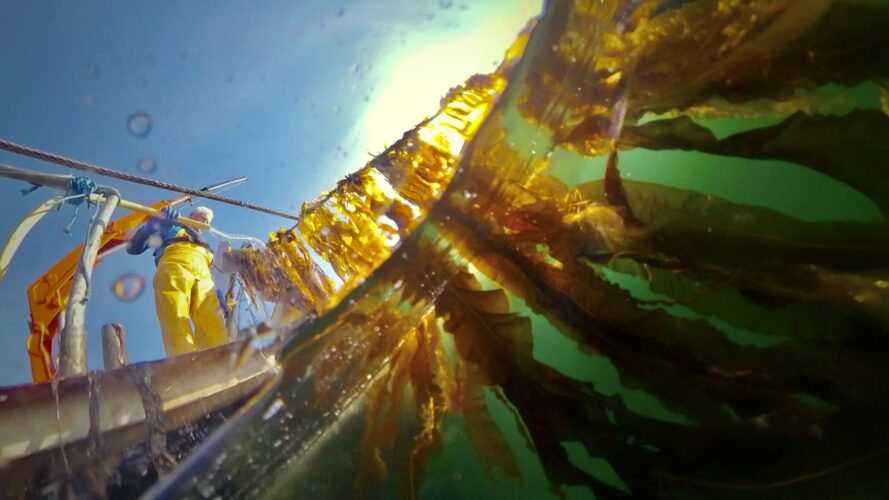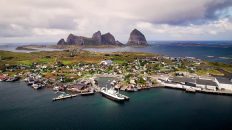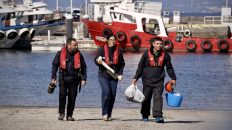Our seas are facing mounting pressures from climate change, pollution, and overfishing. This grim reality threatens the catches and the livelihoods of countless fishers. Could emerging alternatives like seaweed farming help restore our oceans and secure a more sustainable future for fishers?

The clear waters of Mulroy Bay in northwest Ireland are ideal for organic aquaculture. Dozens of people cultivate mussels, oysters, and salmon here, like former fishermen Jerry Gallagher.
“We draft netted for salmon, we fished crab, we fished lobster, we bottom trawled and we gill netted,” Jerry recalls. He turned to aquaculture after fish stocks dwindled, making traditional fishing no longer economically viable.
“The effort per catch now is huge,” Jerry says. “If you gave me a boat now and told me, that’s your boat now, off you go fishing – I would be telling you, you just keep the boat, you know, I wouldn’t do it.”
Undersea harvest
Now, Jerry’s operations extend beyond shellfish. Mulroy Bay is home to the flourishing algae farm spanning dozens of hectares. On underwater lines grow edible seaweeds such as alaria esculenta, also known as Atlantic Wakame, a well-known local species and a traditional food in many North Atlantic countries.
Jerry’s daughter Lorraine, who studied human nutrition, manages the company. Her interest in the potential health benefits of a seaweed-based diet, inspired by longevity trends in countries like Japan, led her to launch this venture. “I realised that we have such an amazing coastline here in Ireland,” Lorraine says. “My family worked in aquaculture, so my brain just started ticking and I said, I think there’s a huge potential here with seaweed!”

The seeding begins in October and by April the seaweed is ready for harvest. Jerry Gallagher says that this work is ideal for those coming from fishing and aquaculture, offering them valuable employment during the quieter seasons.
“People coming from fisheries — totally, that’s ideal,” he stresses. “They would all have a bit of a passion for the sea, skills with ropes and with boats and with engines and stuff, which are pretty essential for everyday operations.”
Demand surge for seaweed
The demand for seaweed is rising across Europe, as it’s increasingly seen as part of a healthy diet. Local organic producers like Jerry and Lorraine Gallagher highlight the environmental benefits over foreign imports. Harvested from the clean waters of Mulroy Bay, this seaweed can even be eaten raw.
“It’s absolutely delicious,” Lorraine declares, as she samples a morsel of freshly harvested seaweed. “It has a beautiful, crunchy bite. Very sweet. The saltiness of the sea. It’s beautiful.”

The company supplies seaweed to the food industry. Its new factory located close to the farm processes 300 kilograms of seaweed per hour, turning it into dry flakes. These flakes are easy to store, transport, and use in food products. Such facilities help scale up seaweed farming in Europe, while creating jobs for those in traditional coastal industries like fishing and mussel farming.
At her processing plant in Mulroy Bay Lorraine talks of a community-based operation: “We have people from other aquaculture sectors that work with us. Mussels have a season which is the opposite to ours. It means that when we are busy they are quiet and vice versa. And it’s wonderful to be able to share those skills and also that knowledge.”
Backing for coastal communities
The Irish government backs seaweed farming as a sustainable way to diversify income and support coastal communities that have faced significant reductions in fishery quotas in recent years. On a visit to the Gallaghers’ plant Ireland’s Minister for Agriculture, Food and the Marine, Charlie McConalogue, said: “In Ireland, we have suffered an impact as a result of Brexit. I’ve seen 15% of our national quota lost to our sector, which is a big impact. And the potential of seaweed really offers a real opportunity there.”
Ireland’s unique position could make it a leading seaweed producer in the European Union. The Atlantic Ocean and the North Sea provide ideal conditions for this emerging industry. Currently, most European seaweed is wild-harvested and often used as soil fertiliser. But new food-grade farming sites are popping up along the coastlines, promising a significant increase in production.
Sustainably managed seaweed farms do more than grow healthy food and create jobs for former fishers. They also help restore ocean health and protect coastlines from erosion, potentially turning the tide for Europe’s coastal economies.

Seafood for thought
At a conference organised by The Seaweed Company in the nearby town of Downings speakers highlighted the environmental advantages of seaweed over traditional agriculture, and discussed the need to streamline regulation and licensing. Both European administration and industry stakeholders share a vision of imminent growth for the sector. Among the participants was Felix Leinemann, Head of Unit for Blue Economy Sectors, Aquaculture and Maritime Spatial Planning, DG MARE: “Europe produces 0,2% of algae in the world,” he said. “But we import 500 million worth of algae every year.
“And this is projected to grow because of increasing demand. People wanting to eat healthier food. More sustainable food. And this is why we have this EU Algae initiative to scale up production around Europe.”
“In food, as a food ingredient, we will have a new life for seaweed. It will grow,” says another attendee, Vitor Verdelho, General Manager, European Algae Biomass Association:

“It’s a guarantee that we already have. There is a big movement to have other sources of protein, other sources of fibres,” he adds.
Seaweed could partially substitute meat in usual diets. The Seaweed Company is marketing its own meat blend with 25% seaweed. They claim this reduces environmental impact by a quarter and enhances nutritional value. Stefan Kraan, Co-Founder and Chief Scientific Officer, The Seaweed Company says it’s also a very versatile and enriching product, says Stefan Kraan, Co-Founder and Chief Scientific Officer, The Seaweed Company:
“It gives a better flavour to the food. But with the seaweed, you also will bring in fibre, and especially carbohydrates, complex carbohydrates that have a function to play in your gut. So it’s gut health. And then the whole mineral profile that will add to your food essential macronutrients and micronutrients, for example, calcium and magnesium.”
And for former fishermen like Jerry Gallagher, seaweed farming offers a way to continue their life passion — working at sea while providing healthy, locally grown food to more people.
“Seaweed is definitely the future for us,” Jerry says confidently. “We will be producing more and more species, and will be working with more and more people, researching new species to grow, to cultivate – and yeah, hopefully it will save the planet!”





